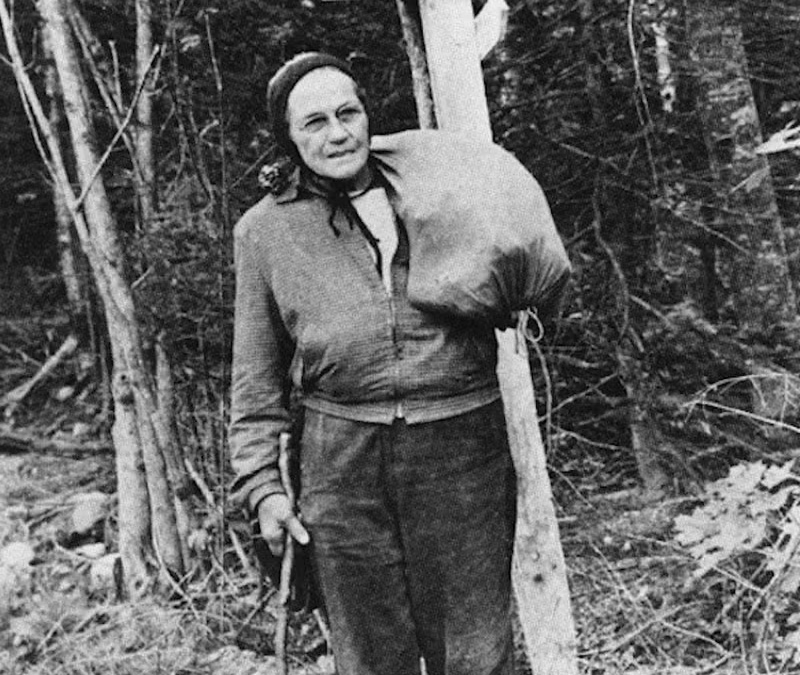“I would never have started this trip if I had known how tough it was, but I couldn’t and wouldn’t quit.” Emma Gatewood
Early May 1955 – Gallipolis, Ohio: Emma Gatewood knew her 11 children would not approve of this adventure at her age, so she told them she was going for a walk. It would be months before they learned the exact location of the 5-foot, 2-inch, 67-year-old grandmother.
Gatewood had been fascinated by the idea of hiking the Appalachian Trail since reading about it in National Geographicsix years earlier. The story made the rugged 2,050-mile mountain trail, which stretched from Georgia to Maine, seem easy. It referred to the AT as “A walk in the park with wide trails, food available from hospitable households, and plenty of trail-side shelters along the way.”
Gatewood flew to Atlanta, and then on May 3 at Mt. Oglethorpe, Georgia, the southern terminus of the AT, she began her walk. She set out with 17 pounds of supplies in a large bag that she had sewn for the trip. There was no map, tent, or sleeping bag. She packed a shower curtain for rainy days and an Army blanket for cold nights. She wore jeans and an old pair of Keds sneakers and packed Vienna sausage, apples, raisins, and peanuts for the journey.
Gatewood had a hard time following the white rectangular markings on the narrow footpath trail. She got lost several times in the first three days. By the end of the week, she had walked only 30 miles, was out of food, and almost out of hope. A forest ranger encouraged her to go home. But if she quit now, what would she tell the people back in Ohio?
She was captivated by the fact that no woman had walked the entire trail alone. She pressed on. The hard life of raising 11 children on an Ohio farm had prepared her for the challenge.
Often the trail shelters were in disrepair or flea-infested. Most nights Gatewood slept on the ground. And National Geographic failed to mention the snakes. She used her walking stick to fend off a copperhead and several rattlesnakes. In late May in Gatlinburg, Tennessee, she rented a hotel room for a night, got a hot bath, restocked on food, and bought a new pair of Keds.
On June 20, the 48th day of Gatewood’s walk, she crossed from North Carolina into Virginia. The Roanoke Timesnewspaper published an article about the walking grandmother, whom they called Grandma Gatewood. The Associated Press picked up the story and it spread across the country.
By mid-July, Grandma Gatewood had survived 60 mph winds and torrential rainfall from Tropical Storms Connie and Diane and was in southern Pennsylvania. To their surprise, several of her children read about their spunky, spirited mother in an Ohio newspaper. But there was no stopping her now.
During August and September, Gatewood, now confident she could finish the trail, trudged on through New York, Massachusetts, Vermont, New Hampshire, and Maine. By then, the Associated Press was providing daily updates on the walking grandmother, and most of America was pulling for her.
On September 25, 1955, Emma Gatewood reached the 5,200-foot summit of Maine’s Mount Katahdin, the northern terminus of the trail, becoming the first woman to solo hike the Appalachian Trail. Despite storms, snakes, arthritic knees, and worn-out shoes, she had walked the 2,050-mile trail in 146 days, averaging 14 miles a day. Her journey took her through 14 states, eight national forests, and two national parks. She climbed 300 peaks more than 5,000-feet in elevation and wore out seven pairs of Keds along the way.
Gatewood’s 5-month walking odyssey garnered national attention for the little-known hiking trail, and her assessment of bad sections along the trail secured funding for much-needed improvements, shelters, and trail repairs. Two years later, she hiked the trail again to celebrate her 70th birthday, and in 1964, she became the first person to hike the AT three times.
Emma Gatewood became an Appalachian Trail legend late in her life, with several books and documentaries written about her. She paved the way for women hikers. Today, 3 million visitors annually hike a portion of the trail, but just 21,500 people have completed the entire length in its 90-year history. One-third of those who go the distance are female. “It didn’t take fancy hiking equipment, maps, or youthfulness,” said Gatewood of her walks. “It took putting one foot in front of the other, five million times.”

Emma was a tough old lady. Fantastic story Pete.